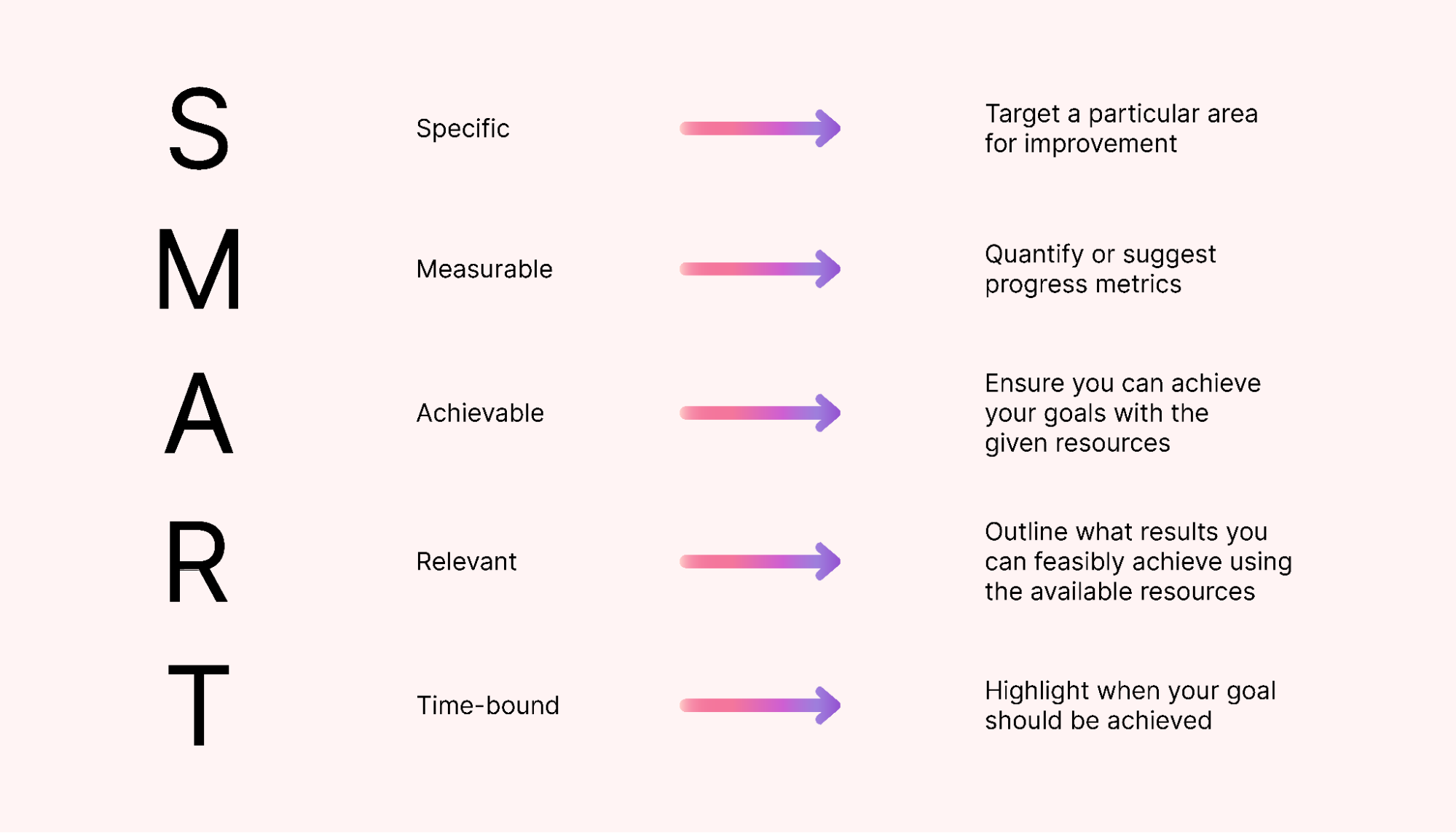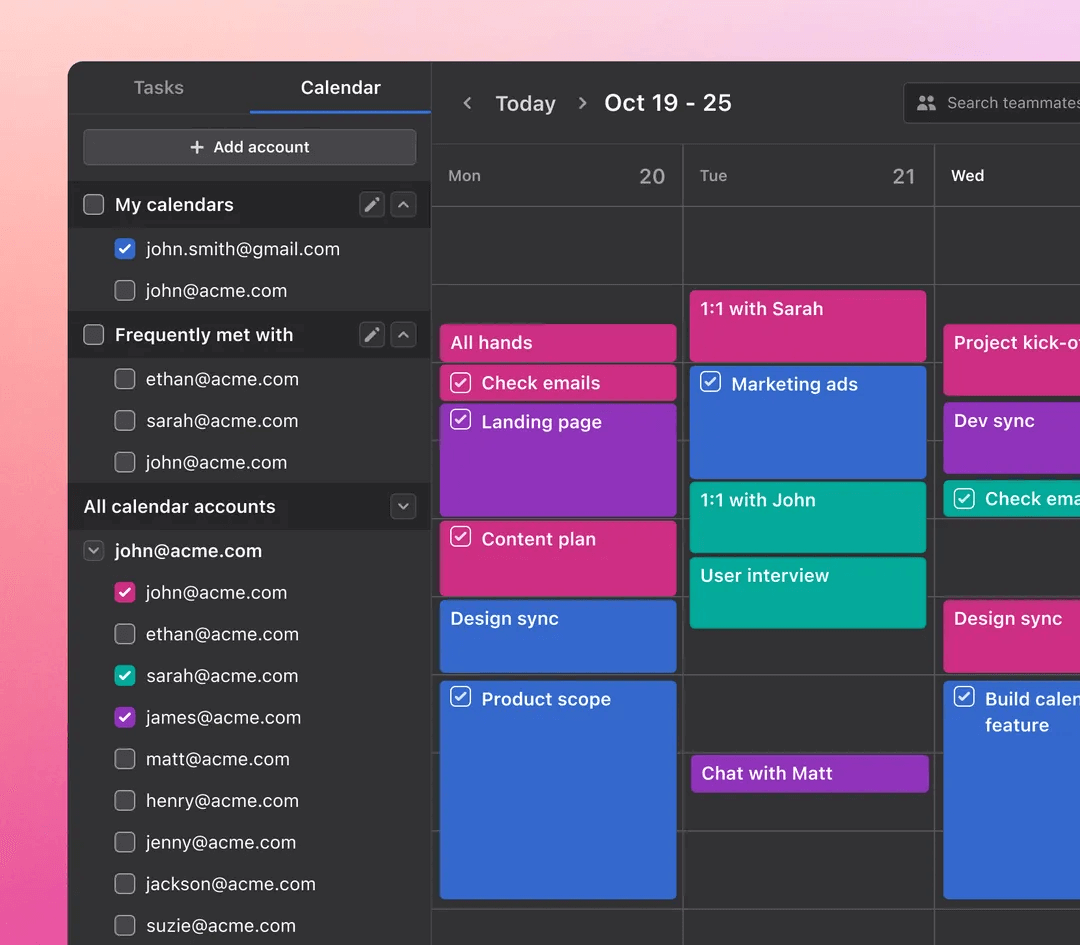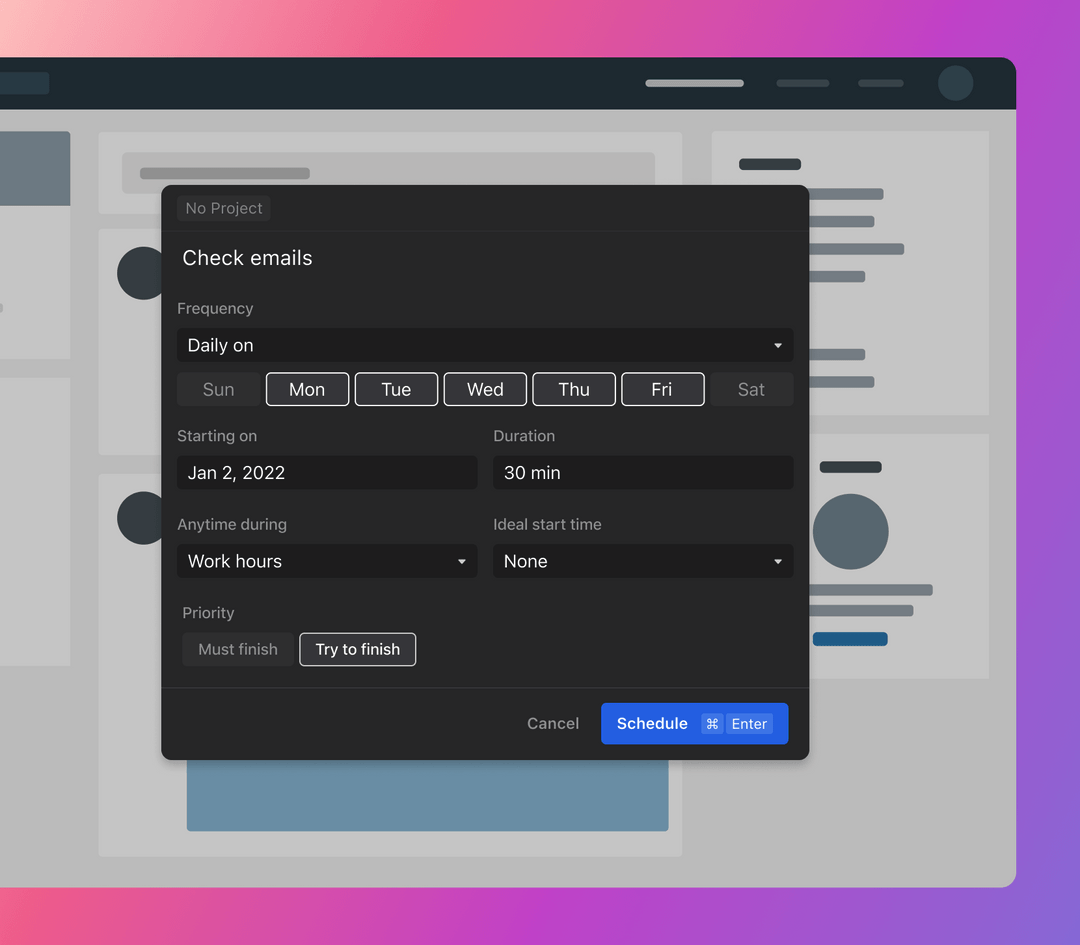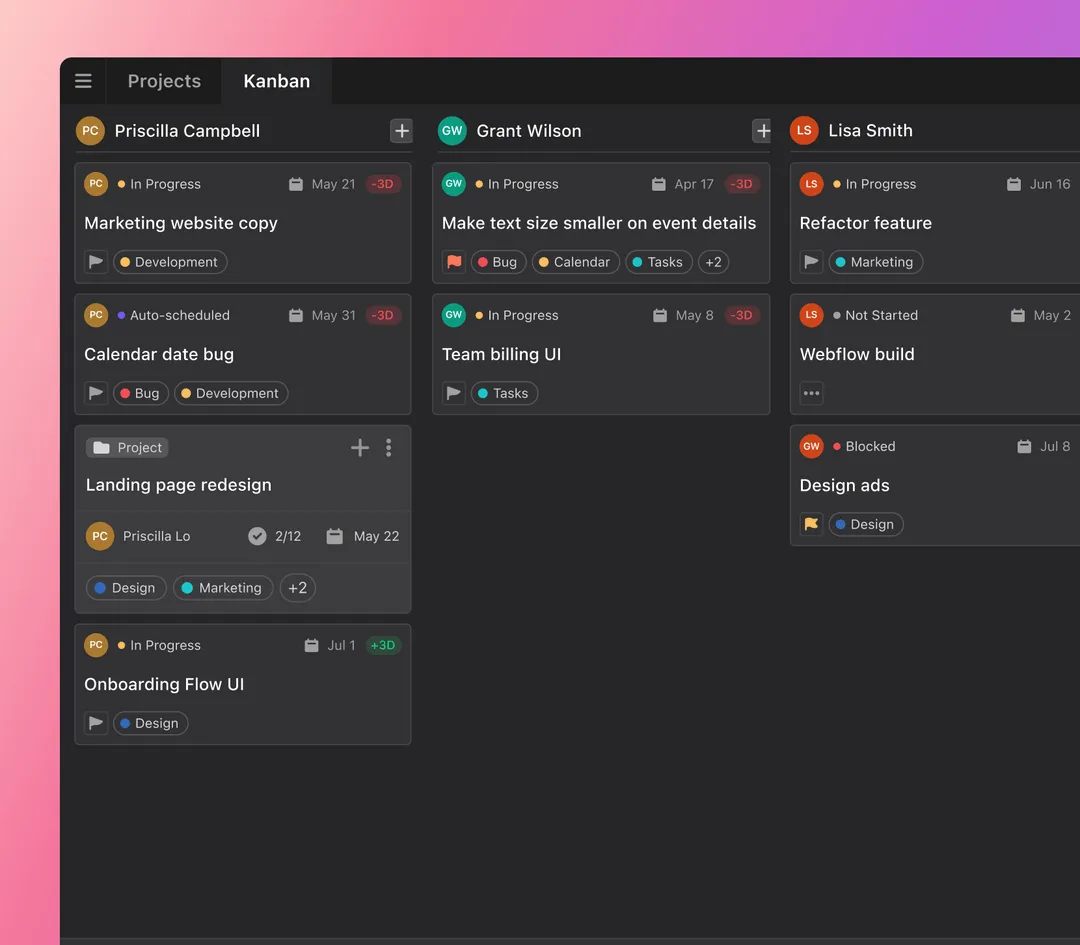Do you rarely hit the mark when you set out to achieve something? Do team goals become lost in translation, lack clarity, or seem unreachable?
These scenarios are all too common — only 5% of businesses achieve all their goals. What often stands in the way is an unrealistic understanding of the effort involved. When we’re not realistic about what it takes to achieve a goal, the road to success becomes too difficult too quickly, and we usually give up.
So how do you set goals that lead to tangible results? Try using SMART goals.
In this article, we’ll cover the essentials of setting SMART goals, explore SMART goal examples for work, and provide tips to help make your team’s objectives more attainable.
What are SMART goals?
The idea behind SMART goals is to break down objectives into concrete, actionable steps.
“SMART” stands for the following:
 |
SMART goals can help you transform abstract ambitions into a structured action plan, making them easier to follow through with.
SMART goals vs. regular goals
When it comes to effectiveness and achievability, there’s a stark contrast between SMART goals and regular goals.
Imagine you’re a sales manager. A regular goal might be, “I want to increase sales.” This is a great aspiration, but it lacks clarity and specificity. By how much do you want to increase sales? Over what timeframe? Using what strategies?
A SMART goal would be, “I aim to boost sales by 15% over the next quarter through targeted email campaigns, in-depth training for the sales team, and the expansion of our client outreach.” This goal isn’t just specific — it’s measurable, achievable, rooted in reality, and has a set timeframe.
The major difference between SMART and regular goals is clarity and direction. SMART goals make the desired outcome more tangible by clarifying the steps needed to achieve them.
5 benefits of setting SMART goals with your team
Although goal-setting is beneficial for teams, only 9% of companies actively involve their peers in the process, and only 15% engage their entire teams.
This lack of collective involvement is a missed opportunity to experience the benefits setting SMART goals with your team can bring.
Here’s what you stand to gain when your team works together toward agreed-upon SMART goals:
1. More focus and direction
SMART goals remove confusion and ambiguity, giving teams a laser-focused path to follow. In fact, Microsoft’s 2023 State of Goal Setting Report suggests that half of employees feel driven and purposeful when their goals are crystal clear.
Setting precise objectives allows your team to better channel their energy and efforts toward achieving them.
2. Better collaboration and communication
When goals are transparent, your team naturally collaborates better. Why?
Clear objectives help team members understand their role and their importance in the grand scheme of things.
 |
Creating a unified vision not only fosters teamwork but also enhances communication. As everyone aligns with the same targets, misinterpretations and miscommunication are minimized. Thus, it becomes easier to work toward shared milestones.
3. Professional and personal growth
SMART planning makes both short- and long-term goals more achievable. With a clear agenda, team members can manage both, and, as a result, they continuously develop new skills and insights as they work on smaller initiatives or personal growth goals to get closer to the big-picture objectives.
Aligning attainable daily tasks with bigger objectives means every success becomes a stepping stone to greater personal and professional growth.
4. Keep everyone accountable and on track
Setting SMART goals means setting clear expectations. Precise targets and deadlines keep everyone on the team accountable for their tasks and productivity.
When employee goals are aligned with organizational priorities and employees hold themselves accountable, employee performance increases by up to 22%. The result is a team that consistently hits targets and celebrates successes.
5. Higher success rate in achieving objectives
A well-laid-out plan empowers your employees to jump into action with confidence. When team members feel confident and connected with their goals, 55% are more self-driven, and 44% show a deeper commitment to the company.
Not only that but over 1,000 studies have consistently shown that setting specific goals is linked to better task performance and more persistence and motivation.
Tips for setting SMART goals for work
But how do you go from understanding SMART goals’ significance to actually planning them? Let’s get into some tips for setting SMART goals that are actionable and achievable.
1. Be specific
Clarity is crucial to setting effective goals. You need to define what you want to achieve in clear terms because the clearer you are, the easier the goal will be to follow through with.
Instead of general aspirations, like “increase customer satisfaction,” zero in on precise targets. For instance, aim to increase customer satisfaction through employee training and integrating chatbot technology into your website to serve customers looking for a self-service solution to their questions or concerns.
2. Make your goals measurable
Measurable goals help you keep track of your progress and successes. Use key performance indicators to track specifics like monthly customer feedback scores or quarterly survey results.
 |
Say your goal is to improve customer satisfaction by 10% by next quarter, and it’s currently at 70%. You know you need to reach a rating of 77% by the end of the quarter.
To stay on track, break the goal down into smaller steps, and review your progress monthly. If you aim for a roughly 2 to 3% increase each month, you’ll have clearer, smaller milestones to hit.
3. Keep your goals ambitious but achievable
Goals should challenge your team, but they also need to be attainable. Setting impossible-to-meet goals can demoralize the team and undermine the purpose of goal-setting in the first place.
It’s also important to consider influencing factors. Make sure resources, such as training, budget, and time, are available to make this 10% increase possible.
For example, are there known issues currently affecting customer satisfaction? If yes, can they be addressed in the next three months? Perhaps hiring more customer service staff or an updated product feature can resolve those issues.
4. Make sure your goals match your plan
Individual or team goals shouldn’t just be a target on their own but part of a cohesive strategy that pushes the entire business toward your larger objectives.
Ask yourself, “How does increasing the customer satisfaction rating by 10% align with the company’s overall objectives?” Maybe the company’s broader mission is to become the industry leader in customer experience. The goal then directly contributes to that vision by working to satisfy customers.
5. Set a timeline
Setting clear timelines instills a sense of urgency and drives commitment. Without them, even the most diligent team members can give in to procrastination.
You can schedule monthly check-ins to track your progress. Following our example, you should improve by 2 to 3% every month to achieve your goal, so by the end of the first month, you need to hit a 72 to 73% satisfaction rate. These time-based check-ins not only make sure you’re on track but also allow for necessary adjustments if any challenges suddenly pop up.
3 examples of SMART goals for work
SMART goals turn big dreams into concrete steps. Here are three work examples to show you how these goals make tasks easier and generate better results.
1. Boost sales performance
Imagine you’re a budding tech startup. Your company has been steady with sales, but your quarterly financial reports suggest a need for higher revenue.
 |
Specific: You’ve decided to increase revenue in the next quarter by applying targeted marketing strategies, retraining the sales team, and expanding your customer base.
Measurable: By the end of the next quarter, you want to achieve a 15% rise in sales. To track progress, you’ll monitor monthly sales data, feedback on new marketing strategies, and the number of new customers acquired.
Achievable: To attain the 15% sales increase, you’ll need to revamp your marketing strategies to reach untapped demographics, provide advanced training sessions, and network at industry events.
Relevant: Increasing sales by 15% aligns with the company’s broader mission to expand and solidify its market position. This growth will aid in funding future product development and business expansions.
Time-bound: The sales team has a time frame of precisely three months to achieve this 15% sales growth. Bi-weekly meetings will be scheduled to assess progress and recalibrate strategies if necessary.
2. Build a more collaborative team
The past couple of months have seen some serious project delays. After reviewing recent feedback, you notice teams are often working in silos, leading to inefficiencies.
Specific: Your objective is to enhance team collaboration through bi-weekly team-building sessions and by introducing an online collaboration tool (like Motion).
Measurable: You aim to boost project collaboration by 30% after three months. To monitor progress, you’ll measure the frequency of collaborative sessions, track tool usage, and ask for feedback on team communication dynamics.
Achievable: The HR department will organize engaging bi-weekly team-building exercises, and the IT team will educate and train the team on using an online collaboration platform.
Relevant: Increasing collaboration is a relevant goal that aligns with the company’s broader vision of an integrated, efficient workforce. Improved collaboration means projects get completed faster, resulting in higher customer satisfaction.
Time-bound: The timeline for this collaboration boost is three months. Regular check-ins at the end of each month will help assess how the team-building sessions and collaboration tool are enhancing team unity. Adjustments will be made based on feedback to ensure progress toward the goal remains on track.
3. Reduce operational costs
The financial department has highlighted a rise in operational costs in the past year and recommends a 20% reduction target to maintain profitability. After assessing the various factors involved and evaluating potential savings areas, you realize a 20% reduction is impractical.
Specific: You aim for a 12% cost reduction over the next year by automating processes, renegotiating vendor contracts, and implementing green measures.
Measurable: You plan to check monthly expenditures to track savings. By the end of each quarter, a 3% reduction in costs should be evident to stay on target.
Achievable: While a 20% cut seems too ambitious, a 12% reduction appears reasonable after a thorough analysis. The company can still achieve significant savings by adopting technological solutions, revisiting vendor contracts, and transitioning to green initiatives.
Relevant: Cutting down on operational costs is critical to maintaining profitability and ensuring the company’s financial health, especially since the recent spike in expenses has raised concerns.
Time-bound: The goal is to achieve this 12% reduction by the end of the year. Regular monthly check-ins and quarterly reviews will be necessary to keep the company on track.
Tips for helping your team implement SMART goals
Setting SMART goals is only half the battle. The real challenge is ensuring your team effectively implements them. As a leader or manager, it’s your job to guide your team through the SMART goal-setting process.
Take a look at our tips to make this transition smoother:
Share goals (including your own) publicly
Publicly sharing goals nurtures transparency and strengthens trust within the team, especially if leadership also participates. Open communication about your goals is a great way to create a united sense of purpose and reinforce the idea that everyone is working toward something bigger.
Motion’s Kanban view lets your team visually track everyone’s progress, ensuring everyone remains accountable throughout the duration of a project.
Use a schedule to keep everyone aligned
A shared schedule helps everyone on the team stay on the same page regarding important milestones and deadlines. It not only keeps them aligned but also ensures clarity on tasks and their respective timelines.
 |
Motion’s intelligent team calendar enables effortless collaboration and alignment. It uses AI automation to optimize everyone’s schedule to fit their respective goals. This means every team member knows their responsibilities and timelines for completing their tasks.
Encourage regular review and adjustment
The importance of setting goals is clear. However, in practice, fewer than half (44%) of employees adjust their goals when needed.
 |
Encourage your team to review their goals regularly and revise them based on shifting circumstances. Motion’s recurring tasks feature can automate these reviews, making it easier to keep everyone on track and goals up-to-date.
Recognize and reward successes
According to the progress principle, even small wins can dramatically boost motivation and morale. So celebrate achievements, whether they’re monumental or minor. Rewarding hard work and offering incentives or other rewards can further fuel your team’s drive.
 |
Motion’s platform allows you to instantly communicate with your team, making it easy to offer on-the-spot praise and assistance. With Motion, no achievement goes unnoticed.
Motion helps your team achieve their goals
The road to setting and achieving goals may not be easy at first, but Motion can help make the process smoother.
Our features are built to simplify the goal-setting process, making every step more intuitive and actionable. With progress tracking, direct communication channels, schedule optimization, and recurring tasks, your team can stay aligned, motivated, and always on track to meeting its objectives.
Get SMART by starting your 7-day free trial with us now.






